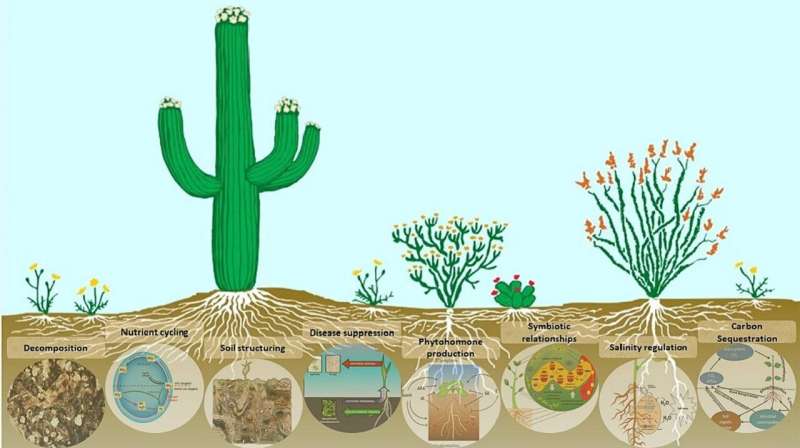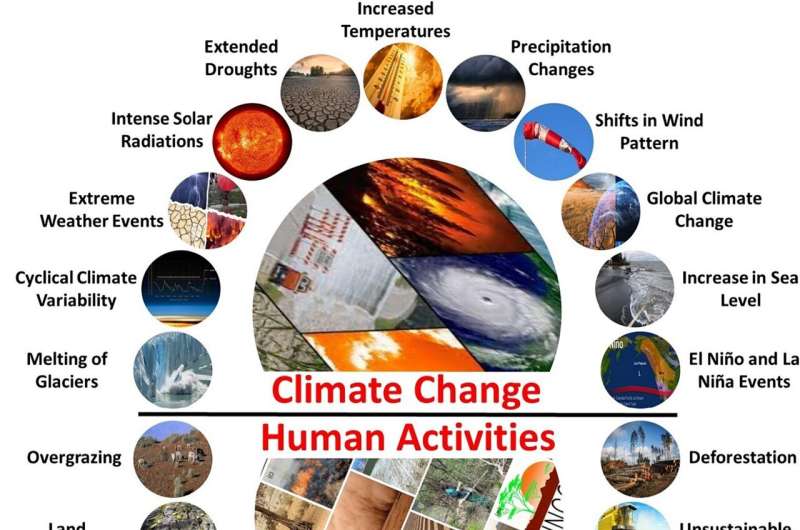March 27, 2024 feature
This article has been reviewed according to Science X's editorial process and policies. Editors have highlighted the following attributes while ensuring the content's credibility:
fact-checked
peer-reviewed publication
trusted source
proofread
Mighty microbes: Soil microorganisms are combating desertification

Desertification is a significant problem for arid, semi-arid and dry sub-humid regions of Earth, whereby grasslands and shrublands become a comparatively barren desert as vegetation disappears over time. This poses an extreme hazard to local ecosystems, as well as communities who rely on these areas for their livelihoods, by increasing soil erosion and reducing water storage, which leads to a loss of biodiversity and agricultural productivity.
Consequently, there is an ever-pressing requirement for management strategies to alleviate desertification and its impacts.
A new review of current research into combating desertification, published in Earth-Science Reviews, has identified soil microbes as critical to this mission. Waqar Islam, an Associate Professor at the Chinese Academy of Sciences, and colleagues explain how a diverse community of bacteria, fungi, archaea and other microorganisms play vital roles in promoting soil health, ultimately impacting ecosystem functions and sustainable land management.
Desertification results from the interplay of both climate change and anthropogenic activities. Increasing temperatures, changes in precipitation and wind patterns, intensification of solar radiation and more frequent extreme weather events (including droughts and El Niño/La Niña cycles) are among some of the environmental causes. Unfortunately, all of these are predicted to intensify in the years to come as climate change progresses, highlighting how desertification may become an ever-more concerning issue.
These environmental factors are further exacerbated by human interference with the natural world, such as deforestation for firewood and clearing land for agriculture and urbanization; intensive crop growth (especially monoculture), use of chemical pesticides and fertilizers, and inefficient irrigation systems deplete the soil of nutrients; overgrazing by livestock, which causes soil compaction and increases likelihood of erosion; mining; and over-abstraction of groundwater to support a growing global population.

As desertification increases, we are more likely to experience its effects with biodiversity losses and species extinctions, depleted soil nutrients, threats to food security and water supply, increased dust storm occurrence (which impairs air quality and impinges upon human and animal health), and migration of communities away from inhospitable areas leading to both social and economic consequences.
Given all of this, minuscule microbes inhabiting the spaces between soil particles could be a viable solution to managing desertification as they decompose organic matter and impact the cycling of nutrients through the environment to improve soil fertility; encourage sequestration of carbon from the atmosphere through the formation of humus (which further improves nutrient and water retention); stabilize soil to combat erosion through symbiotic relationships with plant roots; and support biodiversity.
For nutrient cycling, soil microbes have significant impacts on the availability of nitrogen and phosphorous to support plant productivity, even in nutrient-poor soils.
Nitrogen-fixing soil bacteria (such as Rhizobium and Bradyrhizobium) convert atmospheric nitrogen to ammonia, which is taken up by plants as ammonium ions. Peas, beans and other leguminous plants form symbiotic relationships with nitrogen-fixing bacteria in their root systems, so they can be important crops to grow in arid regions. Furthermore, symbiotic fungi can extend their hyphal networks deeper into the soil, therefore increasing the nutrient and water availability to root systems to encourage growth.
These same mycorrhizal fungi transport organic carbon compounds from plants to the soil, where they can be sequestered as a glycoprotein known as glomalin, as well as through the formation of humus. Glomalin has the additional benefit of binding soil particles together, aiding stability against erosion.
The research further investigates how strategic application of soil microbes in numerous regions across the planet has had measurable impacts on alleviating desertification. This includes their use when remediating mining sites, such as India's Aravalli Range, to encourage the establishment of pioneer species that enable subsequent vegetation growth, as well as metal-resistant bacteria that can detoxify heavy metal contamination of the land.
Additionally, China's Loess Plateau became a target for the government's "Grain for Green" management plan in the 1990s to combat desertification resulting from deforestation and overgrazing, by promoting afforestation and grassland restoration through the use of arbuscular mycorrhizal fungi, Rhizobium bacteria, Actinobacteria and nitrogen-fixing bacteria. Consequently, farmers noted higher crop yields and increased income.
For the semi-arid Sahel region bordering the Sahara Desert, Africa's Great Green Wall project aims to combat food insecurity, poverty and migration resulting from land degradation. Here, afforestation has been used to create microclimates conducive to soil microbial activity of arbuscular mycorrhizal fungi, Endomycorrhizae fungi and Rhizobium bacteria, which have improved overall soil health. Such projects hinge upon community engagement, making this a vital component of desertification management planning.
Managing urban desertification zones, such as those of the American Southwest, has involved creating microspaces for vegetation, like green roofs and community gardens, as well as planting of trees. Similarly, the Al Ain oasis project in the United Arab Emirates desert has seen improvement in soil water retention from the intentional application of soil microbes.
Diversifying the microbial communities in a particular area of soil increases the likelihood of overcoming environmental stressors, such as drought and pathogens, and therefore supports environmental resilience against desertification. However, tailoring the microbes used to each site is imperative as the microbial communities may react inconsistently in different soil types and climates, as well as their interactions with the native soil microorganisms.
While the success of soil microbe application for desertification is known in the short term, more work is required to determine their sustainability over longer timescales.
The importance of this research lies in the ability of soil microbes to alleviate the stresses of desertification, which not only affects local communities but also, for agriculture, can impact food resources down the supply chain globally. The findings offer hope for more natural and sustainable management of one of climate change's many challenges.
More information: Waqar Islam et al, Unlocking the potential of soil microbes for sustainable desertification management, Earth-Science Reviews (2024). DOI: 10.1016/j.earscirev.2024.104738
Journal information: Earth Science Reviews
© 2024 Science X Network




















